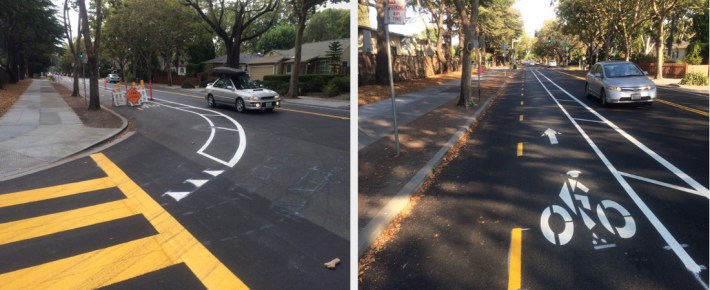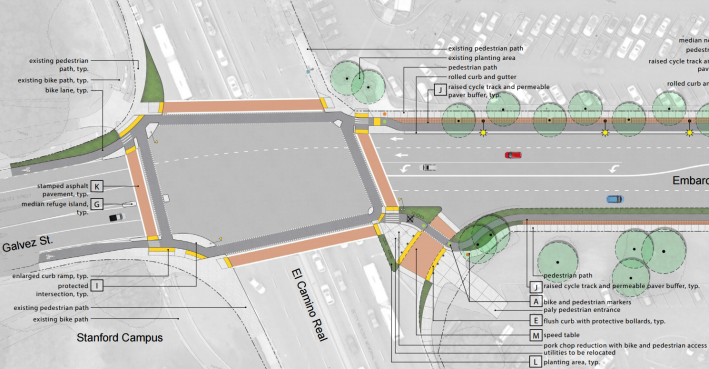
New on-street bike lanes separated from auto traffic are nearing completion in Palo Alto and Menlo Park, and a handful of neighboring cities have plans to install them too. Separated bike infrastructure gained traction among local planners after Caltrans approved Class IV Separated Bikeway design standards [PDF] in December 2015. The first protected intersections were built last year in a handful of North American cities.
A new traffic-separated paved path is nearing completion along Chilco Street in Menlo Park, where a speeding drunk driver hit Balbir and Kamal Singh from behind while they were walking their dog in October 2013, killing them. With no curbs or sidewalks, two 90-degree curves, and poor nighttime lighting, the street’s former design encouraged speeding and crashes involving drivers exiting the roadway.
"I am elated to see how quickly this project has moved forward. The design looks fabulous," said resident Sheryl Bims of the new Chilco Street when it was approved by the City Council in February.
The new paved path, 15 feet wide and separated from the street’s two traffic lanes by a one-foot concrete curb topped with yellow soft-hit posts, is marked for two-way bike and pedestrian traffic. It will extend for one half mile on the north side of Chilco Street from the Dumbarton Rail tracks to Constitution Drive, where the path will transition to existing standard bike lanes. A standard bike lane, but no sidewalk, was installed on the south side of Chilco Street.
That said, in early May Menlo Park's City Council backed away from ambitious plans to replace parallel parking for vehicles with protected bike lanes on both sides of El Camino Real. A one-year pilot project would have created continuous bike lanes separated from auto traffic by curbs or planters--that would have allowed the city to test a consultant's prediction that such bike lanes would help cut both traffic congestion and traffic collisions.

Palo Alto is now installing the city’s first two-way buffered bike lane near Jordan Middle School “to help students and others safety negotiate the North California Avenue/Middlefield Road dogleg intersection.” The new bike lane, which will be separated from auto traffic with white bollards when finished, is intended to accommodate the crush of bicycle traffic during school commute times.
The city installed the two-way bike lanes along with narrower 10-foot wide traffic lanes on Middlefield Road and other safety enhancements after repaving the street in July. But bicyclists will face the same hazardous door-zone bike lanes in both directions in this segment because the city chose to continue allowing parked cars on both sides of the street. California Avenue west of Middlefield Road similarly received smoother pavement and new door-zone bike lanes in July.
Palo Alto is also considering adding separated bike lanes to Embarcadero Road from El Camino Real to Emerson Street just east of the Caltrain underpass. The Planning and Transportation Commission reviewed the plans on August 10, recommending a version with separated bike lanes on both sides of Embarcadero Road that would use the existing sidewalks in the Caltrain underpass, and would connect to a protected intersection at El Camino Real. The city's report [PDF] cautiously notes that "this would be the first protected intersection on El Camino Real which Caltrans may or may not approve."
"The key feature here is the fully protected intersection with the cycle tracks on both sides," noted BKF Engineers Project Manager James Mansfield at the August 10 meeting. "The bike areas are raised and separated from vehicles, and are also separated from pedestrians." The Embarcadero design is scheduled for review by Palo Alto's City Council on September 19.
Palo Alto has installed one other separated bike lane before, a one-block contraflow curb-separated bike lane on Homer Avenue, in 2013.

Neighboring Mountain View has also approved plans to install separated bike lanes on city streets. The four-lane Castro Street from El Camino Real to Miramonte Avenue (one third mile) will be rebuilt in 2017 with two traffic lanes and parking protected bike lanes modeled on those installed by San Jose on Fourth Street in 2012.
Mountain View's 2014 Shoreline Boulevard Corridor Study recommends a median bus-only lane and separated bike lanes, along with a new pedestrian and bicycle bridge over Highway 101 on the west side of Shoreline Boulevard. The plan also proposes a protected intersection at Shoreline Boulevard and Middlefield Road. The city plans to begin building the improvements in late 2017, except for the Highway 101 ped/bike bridge, which awaits the redevelopment of land at Shoreline Boulevard and Pear Avenue.





